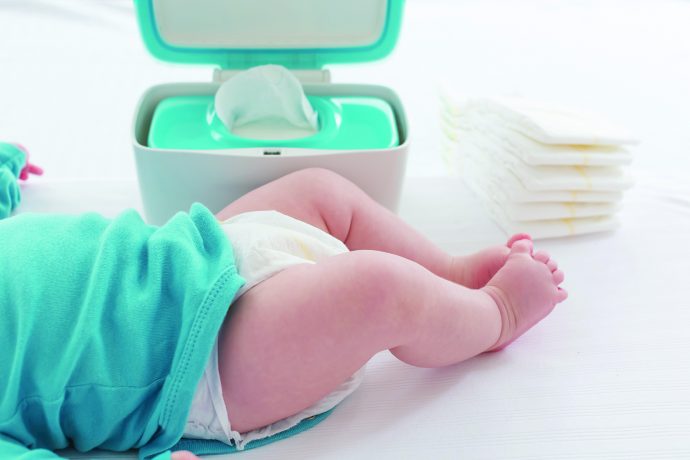Diaper rash is common. One day, while changing your newborn’s diaper, you may notice his bottom or groin area has turned reddish and he seems uncomfortable when you touch it. Most probably, your little one has diaper rash.
Diaper rash is a typical condition affecting babies and toddlers wearing diapers, most common in babies under 12 months old. It is characterised by reddened, inflamed skin in the diaper region, which includes thighs, buttocks and genitals.
Most babies will get diaper rash at some point, but it is usually treatable at home. If you know what to do and how to manage it properly, the rash will subside quickly.
Possible causes
Before looking into ways to manage diaper rash, it is good to understand what causes it. Different causes may require different treatments.
- Irritation: This is the most common cause. Exposure to urine and stool for an extended period causes irritation to a baby’s sensitive skin, especially if one is using less absorbent diapers. Very tight diapers can also cause irritation as the material rubs against the baby’s skin. If the material lining is coarse, it can also create friction and this will lead to a rash too.
- Candida overgrowth: A type of yeast called Candida can be present on normal skin with no symptoms or negative effects. However, if the yeast overgrows, it can cause secondary infection in the nappy area. Overgrowth often happens in warm, moist and softened places with higher skin pH such as under a wet diaper, armpits, neck and breast folds.
- Bacterial infection: Certain types of bacteria transmitted from other people or in the environment may cause a diaper rash or worsen it. A streptococcal infection causes bright red rashes around the anus, while a staphylococcal infection may appear as yellow crusting, boils or pimples.
- Allergy: Babies with eczema or allergies may develop diaper rash after being exposed to irritants or triggers that are present in the products that are used or applied on them, e.g. diapers, baby wipes, soap, lotions, oils, creams, etc. Rashes that are caused by an allergy may also appear on other parts of the body.
- Other causes/factors: Diaper rash is more likely to happen when your baby starts eating solid foods or has changes in his diet. Other rare skin conditions such as seborrheic dermatitis or paediatric psoriasis may also appear as a diaper rash.
Manage & prevent
Other than medication or treatment that may be prescribed by your baby’s paediatrician, good diaper care is so important.
- Pick suitable diapers. The right size, according to the baby’s weight, will determine a good fit. Fast and effective absorbency, as well as breathable and soft materials, are some important factors when selecting diapers for your baby’s sensitive skin. Fragrant-free diapers also reduce potential irritation triggers.
- Change diapers frequently. Wetness from urine and stool causes great discomfort and irritates the skin if left in contact for too long. Yeast and bacteria also love wet and warm places. Be sure to change a wet, soiled or full diaper promptly.
- Clean the skin gently. Rinse your baby’s bottom with warm water when changing diapers. You can also use alcohol- and fragrance-free baby wipes or non-soap cleansers to do this. Gently pat the skin with a towel or let it air dry, but do not rub.
- Go bare-bottomed. Let your baby’s skin dry and breathe naturally for a while as it also helps with the healing process before putting on a fresh diaper.
- Use a barrier cream regularly. This cream acts as a shield for the skin against urine and stool. Products containing zinc oxide or petroleum jelly are good for this purpose. Apply a thick layer every time you change his diaper.
- Don’t over tighten the diaper. Diapers that are too tight can rub against the skin, prevent airflow and trap moisture, giving rise to suitable conditions for rashes to develop. This is especially important for overnight diapers.
Diapers for newborns
Newborns have very sensitive skin and require special care. Breastfed babies will have frequent and loose stools – that’s perfectly normal but things are bound to get messy. Hence, diapers for newborns should be highly absorbent in order to soak up urine and stool residue quickly and efficiently. Diapers made with gentle organic materials also help to prevent irritation and rashes. A good diaper keeps your baby’s delicate skin healthy and dry longer!
Attention!
It is time to see the doctor if:
- The rash worsens or does not improve after five days of home treatment i.e. barrier cream, frequent nappy change, rinsing with warm water and 5 minutes of bare bottom every 6 hours.
- The rash spreads to the skin folds of the groin with new red pimple-like spots called satellite lesions seen along the edges of the rash.
- The rash bleeds, itches, oozes or has open sores
- Your child has a fever or looks sick
- Your child seems to be in pain or discomfort
Babies will recover from a diaper rash within a few days with early and careful management. However, severe cases or infections may require further attention and prescribed medication. Always consult your paediatrician if you have any concerns.
An educational contribution by Malaysian Paediatric Association.








Comments